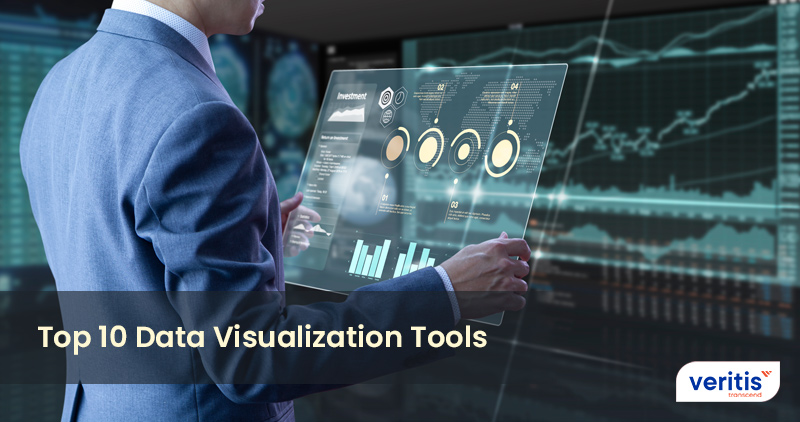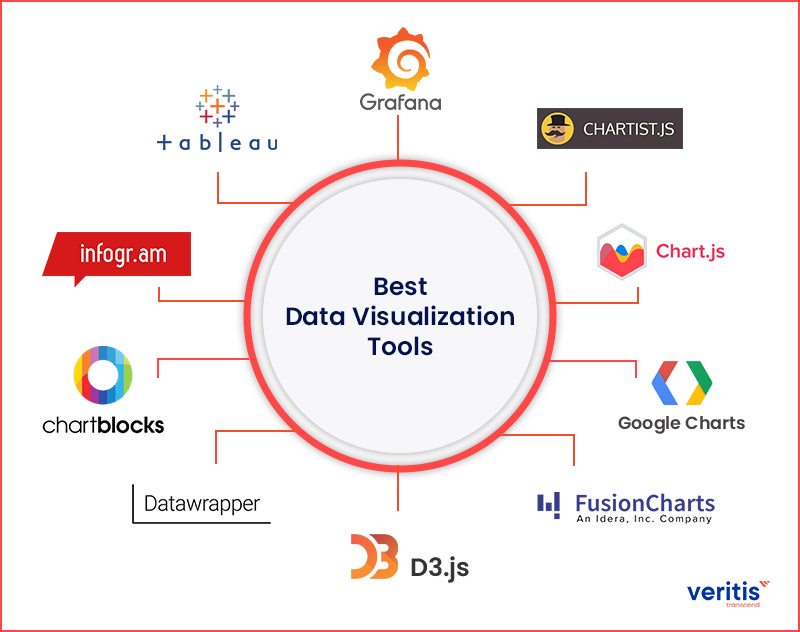
Remaining at the forefront is essential in the ever-evolving landscape of data analytics and information presentation. As we enter 2023 and beyond, the demand for effective data visualization tools has never increased. We’ll explore the top 10 data visualization tools for 2023 and beyond, equipping you with the latest insights to harness the power of data in a visually compelling way.
Data is an effective tool. It enables businesses to identify data visualization trends, conduct analyses, make wise choices, and establish reasonable objectives. However, even with all the data necessary for success, a business can fail if no one knows how to use or understand it.
Datasets can seem like a foreign language for many employees outside of the analytics team. Here is where data visualization is helpful. Professionals can transform raw data into something simple to understand using data visualization.
The global data visualization market is experiencing a growth, with projections indicating that it will produce a remarkable USD 12.48 billion by 2028, reflecting a robust CAGR of 11.6% from 2022 to 2028, as reported by MarketsandMarkets.
This expansion is accompanied by a burgeoning user base, with over 70% of businesses embracing data visualization tools in 2022, as highlighted by Gartner. These statistics underscore the increasing importance of data visualization in decision-making and data-driven strategies across various industries.
Among the plethora of data visualization tools available, Tableau emerges as a dominant player, boasting a market share exceeding 30% in the global data visualization market. Its widespread adoption is attributed to its user-friendly interface and powerful visualization capabilities, making it a preferred choice for firms of all sizes, as MarketsandMarkets indicates.
Alongside Tableau, Microsoft Power BI and Google Data Studio also stand out as the most popular tools in 2023, as reported by G2 Crowd. These tools are pivotal in facilitating data translation into meaningful insights for organizations in the modern data-driven era.
It can be challenging to consume large amounts of data. Large data sets can occasionally make it difficult to extract relevant information from them. Data visualizations play a role in this. However, it is rarely simple to create data visualizations.
It’s different that graphic designers can start from scratch with a data collection with tens of thousands of records and produce data visualization techniques. Yes, it’s technically feasible, but who wants to spend dozens or even hundreds of hours drawing dots on a scatter chart? The latest data visualization tools are helpful in this situation in creative ways to visualize data.
Daily, data scientists must interpret, analyze, and visualize massive datasets. Because of this, they must have access to the appropriate latest data visualisation tools. For example, suppose they give them words on paper or an Excel spreadsheet full of numbers without context. In that case, it can be challenging for people who work less closely with data daily (such as managers or executives) to understand the database visualization tools. Therefore, data scientists can more effectively communicate their findings by using tools to visualize data.
The best data visualization tools for small businesses have been chosen after extensive research. These tools should be adaptable, simple to run, and allow you to visualize data in many ways to meet your business needs. Before going in-depth about the tools for data visualization, go through data visualization and the best data visualizations tools.
What is Data Visualization?

Data visualization is graphically presenting data through statistical graphs, infographics, heat maps, charts, sparklines, and maps of locations. The effective extraction of valuable insights from the data is made possible by the ease of understanding and analysis of data presented through visual elements. Relevant stakeholders can then use the results to inform faster, more effective decisions.
Streaming data support, AI integration, embeddability, collaboration, interactive exploration, and self-service capabilities are all features that bi-visualization tools incorporate to make it easier to represent tools to visualize data.
Although there are countless ways to depict data, some of the most popular methods include the following:
- Infographics
- Heat maps
- Area charts
- Gantt charts
- Scatter plots
- Pie Charts
- Histograms
- Maps
- Waterfall charts
- Bar Charts
- Box and Whisker plots
Why is Data Visualization Important?
Data is frequently easier to grasp and derive insights from when it is represented visually. Therefore, using data visualization software to increase data accessibility throughout an organization is a successful strategy. The result will be more data-driven organizational processes as employees will be empowered to support their decisions with actual data rather than making assumptions.
Data visualization can be crucial in communicating with groups outside a company, such as the media, investors, regulatory bodies, and other stakeholders. Today, many businesses hire people with expertise in tools to visualize data and other data science skills because it has become crucial to modern business.
What are Data Visualization Tools?

A few of the best tools for data visualization are Google Charts, Tableau, Grafana, Chartist, FusionCharts, Datawrapper, Infogram, and ChartBlocks, among others. These visualize data tools must be simple and user-friendly, accommodate a wide range of visual styles, and be able to process massive amounts of data.
Data is becoming increasingly important with every passing day. While making important decisions, any organization can recognize the value of data. Best data visualization software is grabbing people’s interest for the same reason. Advanced data visualization softwares and contemporary data visualization techniques are available.
Software that helps visualize data is known as a data visualization tool. Although each tool has a different set of features, they allow you to input and graphically modify a dataset. Most, but not all, come with pre-built templates for making straightforward visualizations.
What Features Do the Best Data Visualization Tools Share?
All the data visualization technologies currently available on the market share one or more characteristics. Their ease of use is their primary benefit. You will most likely come across two kinds of best data visualization softwares: those that are simple to use and those that make it extremely difficult to visualize data.
Some are user-friendly and have good documentation along with tutorials. However, regardless of their other attributes, some people lack in some areas, which keeps them off any list of the “best” tools. The software’s ability to handle vast volumes of data and various data types on a single display is the one thing you must confirm.
The more advanced software can produce several maps, graphs, and charts. Other companies in the market will undoubtedly present the facts somewhat differently. Some data visualisation tools excel at a single map or chart and specialize in it. These visualize data tools rank among the “best” ones that are readily available. Financial issues are the last to be addressed. Although a higher price does not automatically rule out a tool, it must be justified by better support, more features, and overall value.
The most effective tools can manage large data sets. Even more impressively, the most stunning visualizations can manage several data sets in a single display.
The top data visualization tools can also produce charts, graphs, and map types. Most visualize data tools listed below can produce visual output and interactive graphs. Despite the wide range of output criteria, there are some exceptions. For example, some data visualization platforms specialize in one particular chart or map and excel at it—additionally, such tools rank among the best visualization tools available.
Cost considerations are the final factor. However, a tool’s price does not automatically disqualify it. Better support, better features, and better overall value must justify it. Some benefits are spot patterns, faster decision-making processes, greater accessibility, greater efficiency, and more.
Useful link: Financial Performance Optimization and myHR Analytics for Real Estate Services Client
Benefits of Data Visualization Tools
Data visualization tools offer many benefits that significantly enhance organizations’ data analysis, decision-making, and communication. Here are some key advantages of using data visualization tools:
1) Better Business Decisions
Data visualization tools offer a seamless way to create user-friendly and interactive visuals, simplifying the analysis of intricate datasets on your dashboards. These tools, such as Yellowfin, Power BI, and Tableau, streamline translating complex data into readily comprehensible formats, employing visual elements like charts and graphs. Visual information is typically absorbed more quickly than textual reports, making it easier for a broader audience to grasp key insights.
Presenting data visually within your dashboard renders intricate data accessible and understandable to a broad spectrum of users. This, in turn, fosters improved collaboration and communication throughout the decision-making process and significantly mitigates inaccuracies in data. Consequently, these data visualization tools empower more informed business decisions, contributing to the growth and success of your company.
2) Accelerating the Discovery of Relationships Between Operations and Outcomes
Correlation is a fundamental statistical pillar, serving as a vital tool for uncovering connections between independent variables through data visualizations.
Within the business intelligence domain, the quest for correlation between operational facets and market dynamics is paramount. This endeavor is instrumental in maintaining a competitive edge, enabling the monitoring of interrelations between various business functions and the holistic performance of the market. Doing so empowers more astute strategic decision-making, poised to outpace rivals and drive the growth of your organization.
3) Improving Accuracy in Analyzing Customer Reactions
Utilizing a data visualization platform goes beyond delving into customer emotions, offering analysis through interactive charts, reports, and dashboards rather than wrestling with intricate and disordered spreadsheets.
Through graphs and charts, comprehending and disseminating insights related to public perception of your brand or the overall efficiency of your business operations becomes notably more straightforward. This approach provides the means to delve into the mindset of your target audience, gain insights into their concerns and inclinations, and leverage analytics to forge markedly improved business strategies.
4) Uncovering Obscured Patterns and Deeper Trends
Data visualization software is a critical ally in unveiling concealed data visualization trends. It aids in the identification of intricate patterns and connections that might remain elusive within complex datasets. The outcome is a wealth of profound insights and interconnections.
Take, for instance, the realm of sales forecasting, where data visualization tools shine in their ability to deliver highly precise forecasts. They harness advanced technologies to unearth concealed patterns and present this information through various chart formats, such as bar and line charts. This approach facilitates a more accessible and accurate exploration of market dynamics, enabling deeper insights to be easily gleaned.
5) Effective Communication
Visual representations often convey information to stakeholders and team members more effectively. Charts, graphs, and dashboards simplify complex data and facilitate communication.
When individuals can see data presented visually, it leaves a more robust and lasting impression, aiding in better decision-making and fostering a shared understanding among team members, which is particularly valuable in data-driven environments.
Best Data Visualization Tools

Large data sets can be visualized using dozens, if not hundreds, of different programs, tools, and scripts. However, many of them are pretty simple and share many features.
However, some stand out from the competition because they are either more straightforward to use than the alternatives or have more excellent capabilities for the kinds of visualizations they can produce.
1) Tableau
Tableau provides several options, such as a desktop application, server and hosted online versions, and a free public option. In addition, there are multiple ways to import data, including CSV files, data from Google Analytics and AdWords, and Salesforce data.
The output options include the ability to map and many chart formats. This implies that designers may produce color-coded maps that present regionally significant data in a style that is much simpler to understand than a table or chart could ever be.
Advantages
- Multiple possibilities for importing data
- Map-making abilities
- The public version is accessible for free
- There are numerous video lessons available to help you utilize Tableau
Disadvantages
- The cost of non-free versions is high
- Data analyses cannot be kept private in the public version
2) Infogram
A drag-and-drop visualization tool with full features is called Infogram. Regardless of design experience, it enables anyone to produce compelling data visualizations for dashboards, infographics, social media posts, maps, and more.
The following file types can export finished visualizations: .PNG, .JPG, .GIF, .PDF, and .HTML. It is also possible to create interactive visualizations, which are excellent for including in websites or applications. Infogram provides a WordPress plugin that makes it even simpler for WordPress users to embed visualizations.
Advantages
- A free plan with basic features is included in a tiered pricing structure
- 35+ chart kinds and 550+ map types are included
- Editor using drag and drop
- Using an API to import data from additional sources
Disadvantages
- Built-in data sources are significantly less than those of some other apps
3) ChartBlocks
According to ChartBlocks, data can be imported using their API from “anywhere,” including live feeds. They claim that it only takes a few clicks to import data from any source. Compared to other apps with automated modules or extensions for particular data sources, it will inevitably be more complicated.
The app offers extensive customization options for the created visualization. Before importing the data, the chart-building wizard aids users in precisely selecting the correct data for their charts.
Advantages
- There are both cost-effective and free paid plans available
- The required data can be imported using an easy-to-use wizard
Disadvantages
- How reliable their API is unclear
- It doesn’t seem to be capable of mapping
4) Datawrapper
Datawrapper was developed especially for including graphs and maps in news articles. The developed maps and charts are interactive and designed to be embedded in news websites. The primary way is copying and pasting data into the program, although their data sources are constrained.
Charts can be produced after data has been imported with only one click. They use multiple visualizations, including scatter plots, column, bar charts, election donuts, line, area charts, and choropleth maps.
Advantages
- Explicitly developed for newsroom data visualization
- Smaller sites can benefit from the free plan
- A built-in color blindness checker is part of the tool
Disadvantages
- Very few data sources
- The cost of paid plans is high
5) D3.js
D3.js is a JavaScript library for data-driven document manipulation. Although some apps let non-programmers use the library, D3.js requires some familiarity with JS.
Among them is NVD3, which provides reusable charts for D3.js. Plotly’s Chart Studio enables designers to make WebGL and other charts. And Ember Charts, which also makes use of the Ember.js framework.
Advantages
- Extremely strong and customizable
- Numerous chart types are available
- The emphasis on web standards
- There are tools available for non-programmers to create visualizations
- Open-source software is free
Disadvantages
- Needs programming expertise to utilize alone
- Support is less accessible than with commercial tools
6) Google Charts
A robust and accessible tool for data visualization software called Google Charts is designed to make interactive charts that can be embedded online. The outputs are solely based on HTML5 and SVG, which work with dynamic data. Therefore, they don’t require any additional plugins to function in browsers. Examples of data sources are Google Fusion Tables, Google Spreadsheets, Salesforce, and other SQL databases.
There are many different types of charts, such as maps, scatter plots, column and bar plots, histograms, area plots, pie plots, treemaps, timelines, gauges, and many more. Through easy CSS editing, you can completely alter these charts.
Advantages
- Open source
- Various chart formats are available
- Being HTML5/SVG-based, it is cross-browser compatible
- Employs dynamic data
Disadvantages
- There is little assistance available besides the tutorials and forums
7) FusionCharts
FusionCharts is another JavaScript-based solution for building online and mobile dashboards. It has 1,000 different map types and more than 150 different chart types. It can integrate server-side programming languages and well-known JS frameworks (such as React, jQuery, React, Ember, and Angular) (including PHP, Java, Django, and Ruby on Rails).
FusionCharts offers ready-to-use code for each type of chart and map. As a result, they are making it more straightforward to embed in websites, even for designers with little experience with programming, considering that FusionCharts aims to create dashboards rather than just simple data displays.
Advantages
- Countless chart and map formats are available.
- It has more excellent feature set than the majority of other bi visualization tools
- Combine with different programming languages and frameworks
Disadvantages
- High price (developer license costs start at approximately USD 500)
- Outside of a dashboard environment, this is overkill for simple visualization techniques
8) Chart.js
A straightforward yet adaptable library for creating JavaScript charts is Chart.js. It’s free, offers eight different types of charts, supports animation, and encourages user interaction.
Chart.js generates charts effectively in all current browsers because it leverages HTML5 Canvas for output. It’s fantastic for making mobile-friendly visualizations because the resulting charts are responsive.
Advantages
- Open-source software is free
- Cross-browser compatibility and responsive output
Disadvantages
- Compared to other tools, there are only a few types of charts
- A lack of assistance beyond the official documentation
9) Grafana
With the help of the free program Grafana, users may create interactive dashboards and other visualizations. Furthermore, with the aid of the numerous plugins readily accessible, it can be customized and supports mixed data sources, annotations, and a range of adaptable alert capabilities. It is one of the best visualization techniques as a result.
By leveraging export features, designers can solicit assistance from others and share screenshots of dashboards. Grafana has access to more than 50 data sources via plugins. It is available for free download or if hosted in the cloud, for USD 49 per month. (A very constrained free hosted version is additionally offered.) The downloadable version offers support plans, unlike many other open-source tools.
Advantages
- Open source is available in both free and paid versions
- A wide range of data sources are available
- Numerous chart types are available
- It makes it easy to create dynamic dashboards
- Capable of handling multiple data feeds
Disadvantages
- Added complexity for simple visuals
- Compared to some other tools, it doesn’t provide as many options for visual customization
- Not the most effective method for producing visualization images
- Dashboards cannot be embedded in websites, but individual panels can
10) Chartist.js
The free, open-source JavaScript library Chartist.js can be used to create detailed, responsive charts that are highly customizable and cross-browser compatible. The GZIPped size of the entire JavaScript library is only 10KB. In addition, Chartist.js allows for the creation of animated charts and can be expanded with plugins.
Advantages
- Open source is available in a free version
- A small file sizes
- You can animate charts
Disadvantages
- Not the most extensive range of chart types is provided
- Lack of a mapping capability
- Little assistance from groups outside the developer community
Conclusion
Designers have access to a vast array of bi visualization tools, making it challenging to select one. Designers of data visualizations should consider factors such as tool functionality and ease of use.
Choosing the most robust tool on hand isn’t always the best move: A more straightforward tool can provide the desired result in a much shorter time than a more complex one because learning curves can be high and require more resources to get up and running simply. But remember that the tool is only one component of the process; designers must also consider other factors to produce fantastic tools for data visualization companies.
If the complete product isn’t free, most data visualization tools provide free trials, so it’s worthwhile to try out many before choosing one.
Veritis, the Stevie Award Winner, has provided Fortune 500 firms and start-up businesses with advice and cutting-edge solutions. Veritis has the knowledge necessary to provide a long-lasting solution for data-based services. So, contact us, and we’ll find the ideal solution for your business.
Got Questions? Schedule A Call
Additional Resources:
- IT Infra, Virtualization and Cloud Solutions for Healthcare Industry
- Business Intelligence Converting Data Into Actionable Insights – Whitepaper
- Real Estate IT Business Infrastructure with BI Analytics
- Why Data Driven Culture is Important for You
- Financial Performance Optimization and myHR Analytics for Real Estate Services Client